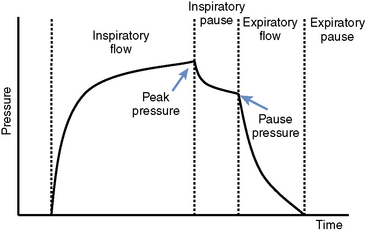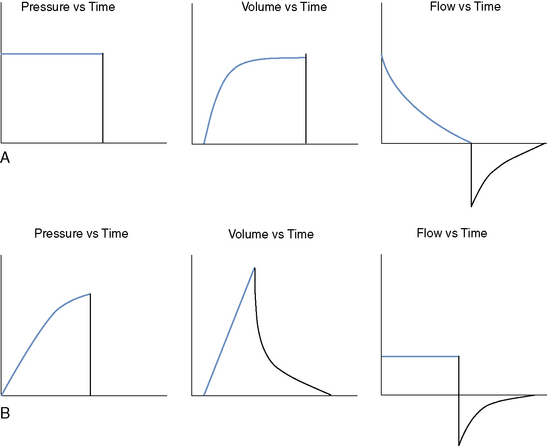Chapter 214 Advanced Mechanical Ventilation
VENTILATOR CONCEPTS
Respiratory Cycle
The respiratory cycle can be divided into four phases: (1) the inspiratory flow phase, (2) the inspiratory pause phase, (3) the expiratory flow phase, and (4) the expiratory pause phase (Figure 214-1).1,2 By defining how each respiratory phase is determined, the ventilator mode can be described. The respiratory phases also provide a context in which to define common ventilator parameters. For example, peak airway pressure is the maximal airway pressure measured during the inspiratory flow phase. The plateau pressure is the airway pressure measured at the end of the inspiratory pause. The difference between the peak inspiratory pressure and plateau pressure is usually minimal in patients with normal lungs. Some pulmonary disease processes that increase airway resistance (e.g., asthma) can cause significant differences between the peak and plateau pressures.
Equation of Motion
Patient-ventilator interactions can be described by the equation of motion. This equation is built into the ventilator software and is the basis for machine operation (Box 214-1).2-4 The equation of motion states that the pressure required to deliver a breath depends on the tidal volume and flow of the breath in addition to the resistance and compliance of the system. The resistance and compliance are determined largely by the characteristics of the patient while pressure, volume, and flow are the three interdependent variables that may be manipulated by the machine. To understand a ventilator breath, knowledge of changes in airway pressure, volume, and flow during each respiratory phase is required.
DEFINING THE VENTILATOR MODE
Breath Types
A ventilator breath is one of two major types: mandatory or spontaneous. During a spontaneous breath, the patient is responsible for both initiation and termination of inspiration. If the machine controls one or both of these factors, the breath is considered mandatory. When a mandatory breath is initiated by the patient, it is classified as an assisted breath. A spontaneous breath in which inspiration is augmented above baseline by the machine is considered a supported breath (Table 214-1).2-4
Control Variable
During a volume-controlled breath the flow and tidal volume are fixed to a level preset by the operator; the machine will maintain a constant gas flow, and the inspiration ends when a preset tidal volume is delivered. As the equation of motion describes, airway pressure reached during these breaths is dependent on the magnitude of the preset tidal volume and the resistance and compliance of the patient’s respiratory system.2-4 The basic waveforms for a pressure-controlled and a volume-controlled breath are shown in Figure 214-2. Exhalation is passive, and it can be seen that it has an exponential character.
Phase Variables
The respiratory cycle helps define the four phases of a breath that can be controlled by the ventilator (see Figure 214-1): (1) the start of inspiration, (2) inspiration, (3) the end of inspiration, and (4) exhalation.2,3
Stay updated, free articles. Join our Telegram channel

Full access? Get Clinical Tree





